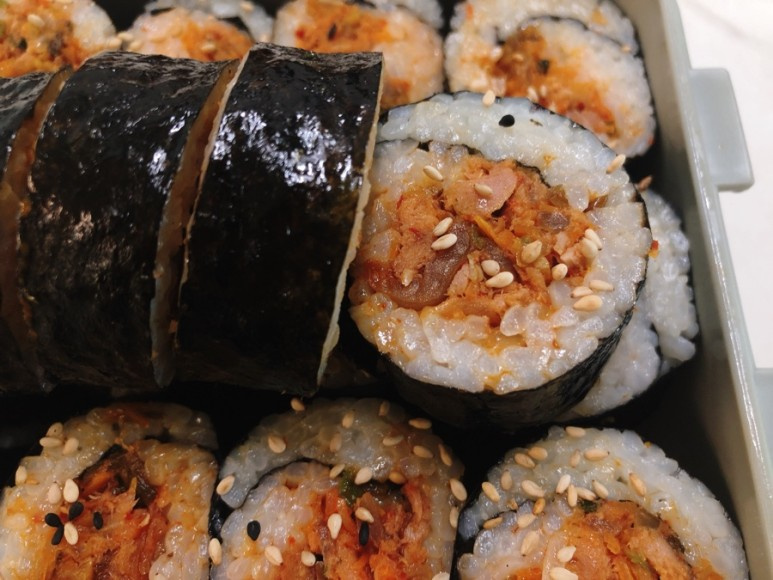Spicy Cheongyang Pepper Tuna Kimbap
Making a Lunchbox with Spicy Cheongyang Pepper and Tuna Kimbap for an Appetizing Meal

My husband loves kimbap and spicy food, so I decided to make a kimbap recipe with plenty of Cheongyang peppers (called ‘ttaengcho’ in Korean). This kimbap is deliciously spicy and flavorful, perfect for packing in a lunchbox or enjoying as a satisfying meal.
Kimbap Ingredients- 3 bowls of warm cooked rice
- 1 can of tuna (150g)
- 1/2 bowl of well-fermented kimchi (mukimchi), finely chopped
- 1 Cheongyang pepper (adjust to your spice preference)
- 1/2 stalk of green onion (white part)
- 1/4 onion
- 1/5 carrot
Seasoning for Kimbap Filling- 0.5 Tbsp Dasida (or other flavor enhancer)
- 1 Tbsp fine red pepper powder
- 1 Tbsp oligosaccharide (or corn syrup)
- 1 Tbsp soy sauce
- 1 Tbsp sesame oil
- 4 pinches of salt (or adjust to taste)
- 0.5 Tbsp Dasida (or other flavor enhancer)
- 1 Tbsp fine red pepper powder
- 1 Tbsp oligosaccharide (or corn syrup)
- 1 Tbsp soy sauce
- 1 Tbsp sesame oil
- 4 pinches of salt (or adjust to taste)
Cooking Instructions
Step 1
First, prepare the kimbap filling ingredients by chopping the vegetables. Finely mince the onion. Minced onion adds a pleasant texture and blends well with the seasoning.

Step 2
Slice the green onion thinly. Adding green onions enhances the overall aroma of the filling.

Step 3
Use a mandoline or knife to julienne the carrot, then finely mince it. The crunchy texture and vibrant color of the carrot will make the kimbap more appealing and delicious.

Step 4
Drain the tuna can thoroughly using a sieve. Removing excess oil is key to achieving a non-greasy, savory tuna flavor.

Step 5
To prepare the kimchi filling, rinse the well-fermented kimchi, squeeze out excess water, and then finely chop it with scissors. Using aged kimchi adds a wonderful depth of flavor.

Step 6
Remove the seeds from the Cheongyang pepper and mince it finely. If you enjoy a spicier kick, you can leave the seeds in. Otherwise, removing them will provide a pleasant, subtle heat.

Step 7
Now, let’s make the stir-fried filling. Heat a little cooking oil in a frying pan over low heat. Add the minced green onion and slowly stir-fry until fragrant, creating green onion oil. Gentle heat prevents the onion from burning and brings out its aroma.

Step 8
Once the green onion oil is fragrant, add the chopped kimchi and stir-fry together for about 1 minute. This process mellows the tanginess of the kimchi and softens it slightly.

Step 9
Next, add the minced carrot, onion, and Cheongyang pepper, and stir-fry for another minute. Cook just until the vegetables are slightly tender.

Step 10
To the stir-fried vegetables, add the seasonings: 0.5 Tbsp Dasida, 1 Tbsp red pepper powder, and 1 Tbsp oligosaccharide. Mix well to coat the ingredients.

Step 11
Add the drained tuna and stir-fry lightly for about 30 seconds, just until the seasoning is incorporated. Avoid overcooking the tuna, as it can become dry and crumbly.

Step 12
Push the stir-fried filling to one side of the pan. Add 1 Tbsp of soy sauce to the empty space, letting it sizzle and slightly caramelize at the bottom before mixing it with the other ingredients. This creates a richer, deeper soy sauce flavor. The filling is now complete!

Step 13
In a bowl, combine 3 bowls of warm rice with 1 Tbsp of sesame oil and about 4 pinches of salt. Gently mix with a spatula, being careful not to mash the rice grains. Taste and add more salt if needed.

Step 14
Lay a sheet of seaweed on a bamboo rolling mat. Spread about 2/3 of the seasoned rice evenly over the seaweed, leaving a 1/3 border at the top edge. This border helps seal the kimbap when rolled.

Step 15
Generously spoon the prepared spicy tuna filling down the center of the rice. Ensure it’s distributed evenly to prevent the kimbap from bursting when rolled.

Step 16
Using the bamboo mat, roll the kimbap tightly. Hold the edge of the mat firmly and push forward to roll. Lightly moisten the top edge of the seaweed with a few grains of rice to help it seal naturally and prevent unraveling.

Step 17
Once rolled, slice the kimbap into bite-sized pieces and arrange them in a container. You’re done! Enjoy your delicious Spicy Cheongyang Pepper Tuna Kimbap, featuring the delightful combination of spicy peppers, savory tuna, and tangy kimchi!



